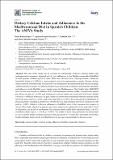Por favor, use este identificador para citar o enlazar a este item:
http://hdl.handle.net/10261/183053COMPARTIR / EXPORTAR:
 SHARE SHARE
 CORE
BASE CORE
BASE
|
|
| Visualizar otros formatos: MARC | Dublin Core | RDF | ORE | MODS | METS | DIDL | DATACITE | |

| Título: | Dietary Calcium Intake and Adherence to the Mediterranean Diet in Spanish Children: The ANIVA Study |
Autor: | Rubio-López, N.; Llopis-Gonzalez, A.; Picó, Yolanda CSIC ORCID; Morales-Suárez-Varela, M. | Palabras clave: | Calcium intake Nutrient intake Adherence Mediterranean diet Children |
Fecha de publicación: | 14-jun-2017 | Editor: | Multidisciplinary Digital Publishing Institute | Citación: | International Journal of Environmental Research and Public Health 14(6): 637 (2017) | Resumen: | The aim of this study was to evaluate the relationship of dietary calcium intake with anthropometric measures, physical activity and adherence to the Mediterranean diet (MedDiet) in 1176 Spanish children aged 6–9 years. Data were obtained from “Antropometría y Nutrición Infantil de Valencia” (ANIVA), a cross-sectional study of a representative sample. Dietary calcium intake assessed from three-day food records was compared to recommended daily intakes in Spain. Anthropometric measures (weight and height) were measured according to international standards and adherence to the MedDiet was evaluated using the Mediterranean Diet Quality Index (KIDMED) test. For the total sample of children, 25.8% had inadequate calcium intake, a significantly higher prevalence in girls (p = 0.006) and inadequate calcium intake was associated with lower height z-score (p = 0.001) for both sexes. In girls, there was an inverse relationship between calcium intake and body mass index (p = 0.001) and waist/hip ratio (p = 0.018). Boys presented a polarization in physical activity, reporting a greater level of both physical and sedentary activity in comparison with girls (p = 0.001). Children with poor adherence to MedDiet, even if they consume two yogurts or cheese (40 g) daily, adjusted by gender, age, total energy intake, physical activity and father’s level of education, are at risk of inadequate total calcium intake (odds ratio adjusted [ORa]: 3.36, 95% confidence interval [CI]: 1.13–9.94, p = 0.001). The intake of these dairy products was insufficient to cover calcium intake recommendations in this age group (6–9 years). It is important to prioritize health strategies that promote the MedDiet and to increase calcium intake in this age group. | Versión del editor: | http://dx.doi.org/10.3390/ijerph14060637 | URI: | http://hdl.handle.net/10261/183053 | DOI: | 10.3390/ijerph14060637 | ISSN: | 1661-7827 | E-ISSN: | 1660-4601 |
| Aparece en las colecciones: | (CIDE) Artículos |
Ficheros en este ítem:
| Fichero | Descripción | Tamaño | Formato | |
|---|---|---|---|---|
| Dietary_calcium.pdf | 361,3 kB | Adobe PDF |  Visualizar/Abrir |
CORE Recommender
PubMed Central
Citations
4
checked on 28-abr-2024
SCOPUSTM
Citations
17
checked on 14-may-2024
WEB OF SCIENCETM
Citations
12
checked on 27-feb-2024
Page view(s)
181
checked on 17-may-2024
Download(s)
130
checked on 17-may-2024



